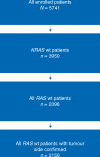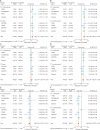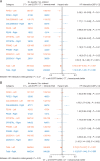Prognostic and predictive value of primary tumour side in patients with RAS wild-type metastatic colorectal cancer treated with chemotherapy and EGFR directed antibodies in six randomized trials
- PMID: 28407110
- PMCID: PMC6246616
- DOI: 10.1093/annonc/mdx175
Prognostic and predictive value of primary tumour side in patients with RAS wild-type metastatic colorectal cancer treated with chemotherapy and EGFR directed antibodies in six randomized trials
Abstract
Background: There is increasing evidence that metastatic colorectal cancer (mCRC) is a genetically heterogeneous disease and that tumours arising from different sides of the colon (left versus right) have different clinical outcomes. Furthermore, previous analyses comparing the activity of different classes of targeted agents in patients with KRAS wild-type (wt) or RAS wt mCRC suggest that primary tumour location (side), might be both prognostic and predictive for clinical outcome.
Methods: This retrospective analysis investigated the prognostic and predictive influence of the localization of the primary tumour in patients with unresectable RAS wt mCRC included in six randomized trials (CRYSTAL, FIRE-3, CALGB 80405, PRIME, PEAK and 20050181), comparing chemotherapy plus EGFR antibody therapy (experimental arm) with chemotherapy or chemotherapy and bevacizumab (control arms). Hazard ratios (HRs) and 95% confidence intervals (CIs) for overall survival (OS) and progression-free survival (PFS) for patients with left-sided versus right-sided tumours, and odds ratios (ORs) for objective response rate (ORR) were estimated by pooling individual study HRs/ORs. The predictive value was evaluated by pooling study interaction between treatment effect and tumour side.
Results: Primary tumour location and RAS mutation status were available for 2159 of the 5760 patients (37.5%) randomized across the 6 trials, 515 right-sided and 1644 left-sided. A significantly worse prognosis was observed for patients with right-sided tumours compared with those with left-sided tumours in both the pooled control and experimental arms for OS [HRs = 2.03 (95% CI: 1.69-2.42) and 1.38 (1.17-1.63), respectively], PFS [HRs = 1.59 (1.34-1.88) and 1.25 (1.06-1.47)], and ORR [ORs = 0.38 (0.28-0.50) and 0.56 (0.43-0.73)]. In terms of a predictive effect, a significant benefit for chemotherapy plus EGFR antibody therapy was observed in patients with left-sided tumours [HRs = 0.75 (0.67-0.84) and 0.78 (0.70-0.87) for OS and PFS, respectively] compared with no significant benefit for those with right-sided tumours [HRs = 1.12 (0.87-1.45) and 1.12 (0.87-1.44) for OS and PFS, respectively; P value for interaction <0.001 and 0.002, respectively]. For ORR, there was a trend (P value for interaction = 0.07) towards a greater benefit for chemotherapy plus EGFR antibody therapy in the patients with left-sided tumours [OR = 2.12 (1.77-2.55)] compared with those with right-sided tumours [OR = 1.47 (0.94-2.29)]. Exclusion of the unique phase II trial or the unique second-line trial had no impact on the results. The predictive effect on PFS may depend of the type of EGFR antibody therapy and on the presence or absence of bevacizumab in the control arm.
Conclusion: This pooled analysis showed a worse prognosis for OS, PFS and ORR for patients with right-sided tumours compared with those with left-sided tumours in patients with RAS wt mCRC and a predictive effect of tumour side, with a greater effect of chemotherapy plus EGFR antibody therapy compared with chemotherapy or chemotherapy and bevacizumab, the effect being greatest in patients with left-sided tumours. These predictive results should be interpreted with caution due to the retrospective nature of the analysis, which was carried out on subpopulations of patients included in these trials, and because none of these studies contemplated a full treatment sequence strategy.
Keywords: anti-EGFR treatment; colorectal cancer; predictive value; prognostic; randomized trial; tumour side.
© The Author 2017. Published by Oxford University Press on behalf of the European Society for Medical Oncology. All rights reserved. For permissions, please email: journals.permissions@oup.com.
Figures




Comment in
-
Whose side are you on?Ann Oncol. 2017 Aug 1;28(8):1685-1686. doi: 10.1093/annonc/mdx270. Ann Oncol. 2017. PMID: 28541394 No abstract available.
-
Right-left or midgut-hindgut?Ann Oncol. 2017 Oct 1;28(10):2618. doi: 10.1093/annonc/mdx282. Ann Oncol. 2017. PMID: 28945829 No abstract available.
Similar articles
-
Tumour location and efficacy of first-line EGFR inhibitors in KRAS/RAS wild-type metastatic colorectal cancer: retrospective analyses of two phase II randomised Spanish TTD trials.ESMO Open. 2019 Dec 1;4(6):e000599. doi: 10.1136/esmoopen-2019-000599. eCollection 2019. ESMO Open. 2019. PMID: 31803504 Free PMC article. Clinical Trial.
-
Primary tumour side as a driver for treatment choice in RAS wild-type metastatic colorectal cancer patients: a systematic review and pooled analysis of randomised trials.Eur J Cancer. 2023 May;184:106-116. doi: 10.1016/j.ejca.2023.02.006. Epub 2023 Feb 17. Eur J Cancer. 2023. PMID: 36913832
-
Chemotherapy With or Without Anti-EGFR Agents in Left- and Right-Sided Metastatic Colorectal Cancer: An Updated Meta-Analysis.J Natl Compr Canc Netw. 2019 Jul 1;17(7):805-811. doi: 10.6004/jnccn.2018.7279. J Natl Compr Canc Netw. 2019. PMID: 31319395
-
Primary tumor sidedness has an impact on prognosis and treatment outcome in metastatic colorectal cancer: results from two randomized first-line panitumumab studies.Ann Oncol. 2017 Aug 1;28(8):1862-1868. doi: 10.1093/annonc/mdx119. Ann Oncol. 2017. PMID: 28449055 Free PMC article.
-
FOLFOX plus anti-epidermal growth factor receptor (EGFR) monoclonal antibody (mAb) is an effective first-line treatment for patients with RAS-wild left-sided metastatic colorectal cancer: A meta-analysis.Medicine (Baltimore). 2018 Mar;97(10):e0097. doi: 10.1097/MD.0000000000010097. Medicine (Baltimore). 2018. PMID: 29517682 Free PMC article. Review.
Cited by
-
Primary Tumor Location and Outcomes After Cytoreductive Surgery and Intraperitoneal Chemotherapy for Peritoneal Metastases of Colorectal Origin.Ann Surg Oncol. 2021 Feb;28(2):1109-1117. doi: 10.1245/s10434-020-08993-7. Epub 2020 Aug 25. Ann Surg Oncol. 2021. PMID: 32844293 Free PMC article.
-
Evaluation of Prognostic Factors for Survival in Transverse Colon Cancer.Cancers (Basel). 2020 Aug 30;12(9):2457. doi: 10.3390/cancers12092457. Cancers (Basel). 2020. PMID: 32872561 Free PMC article.
-
T-Cell Infiltration and Clonality May Identify Distinct Survival Groups in Colorectal Cancer: Development and Validation of a Prognostic Model Based on The Cancer Genome Atlas (TCGA) and Clinical Proteomic Tumor Analysis Consortium (CPTAC).Cancers (Basel). 2022 Nov 29;14(23):5883. doi: 10.3390/cancers14235883. Cancers (Basel). 2022. PMID: 36497365 Free PMC article.
-
Prevalence of RAS and BRAF mutations in metastatic colorectal cancer patients by tumor sidedness: A systematic review and meta-analysis.Cancer Med. 2020 Feb;9(3):1044-1057. doi: 10.1002/cam4.2747. Epub 2019 Dec 19. Cancer Med. 2020. PMID: 31856410 Free PMC article.
-
Considering FOLFOXIRI plus bevacizumab for metastatic colorectal cancer with left-sided tumors.World J Gastrointest Oncol. 2018 Dec 15;10(12):528-531. doi: 10.4251/wjgo.v10.i12.528. World J Gastrointest Oncol. 2018. PMID: 30595807 Free PMC article.
References
-
- Hansen IO, Jess P.. Possible better long-term survival in left versus right-sided colon cancer - a systematic review. Dan Med J 2012; 59: A4444.. - PubMed
-
- Aarts F, de Hingh I, de Wilt JHW. et al. Differences in outcome between right- and left-sided colon cancer: a population based study. J Clin Oncol 2013; 31(suppl 4): Abstract 493.
-
- Verhulst J, Ferdinande L, Demetter P, Ceelen W.. Mucinous subtype as prognostic factor in colorectal cancer: a systematic review and meta-analysis. J Clin Pathol 2012; 65: 381–388. - PubMed
MeSH terms
Substances
Grants and funding
LinkOut - more resources
Full Text Sources
Other Literature Sources
Medical
Research Materials
Miscellaneous

